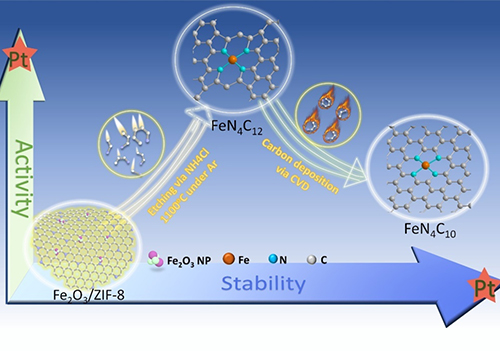What Are You Looking For?
Research on Fe/N/C materials as cathode catalysts in proton exchange membrane fuel cells
Iron/nitrogen/carbon (Fe/N/C) materials are currently recognized as ideal candidates to replace platinum-based catalysts in the cathode of proton exchange membrane fuel cells (PEMFC).
The development of clean, renewable, and sustainable alternative energy sources has become an urgent need. Proton exchange membrane fuel cells (PEMFC) present great application potential. Fe/N/C catalysts, as a typical representative of metal/nitrogen/carbon catalysts, are considered to be the most promising due to their relatively good catalytic activity and stability in acidic electrolytes and their low cost, which is far lower than the cost of PGM catalysts. A cathode catalyst that replaces PGM to catalyze ORR.

Although the application of Fe/N/C materials as cathode catalysts in PEMFC has shown great promise, there are still some issues that require further research and exploration:
(1)Qualitative and quantitative research on active sites is the key to catalytic reactions. For Fe/N/C materials, Research Progress of Fe/N/C Materials in Cathode Catalysts in Proton Exchange Membrane Fuel Cells 5 Essence Its mechanism of action in catalytic reactions will be of great significance to further optimize catalyst performance. Technologies including high-resolution electron microscopy, synchrotron radiation, etc., combined with theoretical calculations, can be used to deeply reveal the structure and properties of active sites and their mechanism of action in catalytic reactions, design and synthesize new catalysts, and achieve control of active sites. effective control of points.
(2)The stability of Fe/N/C materials during continuous operation still needs to be further improved. Exploring how to enhance its stability through material design and preparation method optimization is an important topic in current Fe/N/C catalyst research. It is recommended to try to develop new catalyst supports in conjunction with in-depth research on active sites to improve the stability of the catalyst.
(3)Although Fe/N/C catalysts have shown potential to replace PGM catalysts, their catalytic performance has not yet reached the level of PGM catalysts. Therefore, how to further improve its catalytic performance by improving synthesis strategies and finely regulating the material structure is one of the focuses of future research.